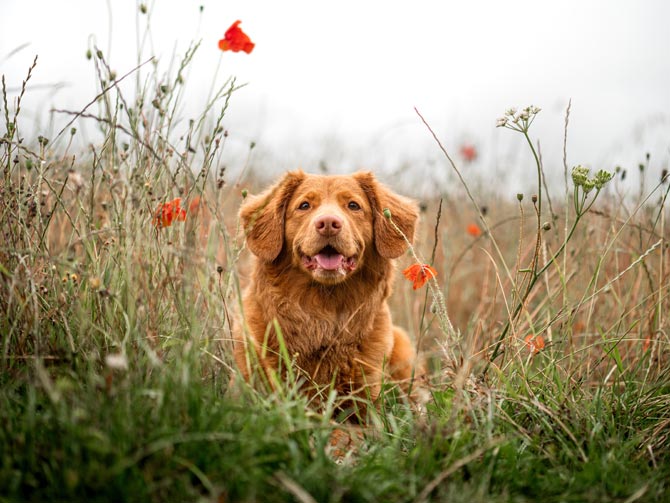When it comes to spring pet care it’s essential to know the potential dangers and how to prevent them from impacting your pet’s health.
From poisonous plants and seasonal allergens to insect stings and fleas, spring pet care is an all-important topic. As responsible pet parents, it’s super important to be aware of the many dangers that present along with the warmer weather.
So, to help us keep our four-legged friends safe, PETstock Vet Dr Alison Kemp has provided us with some expert advice on springtime dangers.
7 spring pet care tips
With spring come warmer days, lighter and brighter mornings and an abundance of potential pet dangers! Yes, that’s right. While we all love the fact that spring has sprung, it does require a little more care and attention to keep our fur babies happy and healthy—and out of harm’s way. Thankfully, we have some wonderful tips from Vet Dr Alison Kemp.
1. Avoid plant-related poisons
“Many Aussie pet parents have also adopted the role of ‘plant parent’ and are likely to purchase or grow more plants during spring. However, it’s vital to remember several of the most popular household plant and flower species can be toxic and even fatal to pets, “ explains Dr Kemp.
“Symptoms of plant or flower poisoning include vomiting, diarrhoea, depression or other abnormal behaviour, seizures, excessive drooling, or weakness. If you suspect that your pet has ingested a poisonous plant or flower, it’s important to contact your vet immediately.”
To obtain a complete list of both toxic and non-toxic plants and flowers, please visit the ASPCA website.
“Luckily, there are many non-toxic options safe for both dogs and cats. These include Blue Echeveria, Burro’s Tail, Bamboo and Ponytail Palm.”
2. Spring allergy awareness
“Just like humans, pets can also experience seasonal allergies. Allergies occur when a pet’s immune system identifies something in the environment as threatening or dangerous. Common springtime allergens for pets include grass, weed and tree pollens, dust and mold. Most symptoms include sensitive skin (red or irritated skin), bald or thinning patches of the fur, itchy and smelly ears, and excessive licking of an area on their body,” says Dr Kemp.
“If your pet does suffer from seasonal allergies, ensure you don’t over-groom them and irritate their skin further and always use a gentle pet formulated shampoo.”
Given that it’s almost impossible to completely avoid exposure to pollen, it may be worth a trip to your local vet who will provide medication to relieve your dog’s allergy symptoms.
3. Practice flea and tick prevention
“Fleas and ticks are common in Australia and can make your pet dangerously ill. Ensure all cats and dogs in your household have been treated with the correct flea and tick protection before allowing them out in the yard. Consistency is key, so be sure you treat your pet now and continue monthly applications throughout the rest of the year,” Dr Kemp advises.
Fleas can be a big headache for pet owners. While there are a plethora of flea products on the market, this can be confusing for pet parents. What’s more, a poor understanding of the flea cycle and how each product works can lead to failure, or ‘perception of failure’ of the product. Whichever product you use you must always:
- Read the instructions on the label
- Treat your pet regularly (not just during ‘flea season’
- Treat all your pets
- Consider fumigating the home
Find out more about flea and tick prevention. https://www.petsecure.com.au/pet-care/guide-flea-prevention-pets/
4. Be aware of insect stings
“With budding flowers in full swing, bee stings are a common threat pets face, particularly curious pets that love spending time in the backyard. Just like humans, pets’ physical reactions will differ in severity when stung,” says Dr Kemp.
In cases of a severe reaction, contact your vet. A vet can provide medication to reduce the pain and swelling, for example, an antihistamine. Additionally, if you can see the stinger but you’re not able to remove it, your vet can assist with this too.
Where the symptoms are mild, you can take the following action.
- Pop an icepack in a towel and hold it on the dog’s wound to reduce the swelling. Don’t have an icepack handy? Wet a face cloth with cold water, wring it out and apply it to the sting.
- Try mixing together a teaspoon of baking soda and some cool water. Apply to the affected area to help soothe the pain.
- If your dog is constantly scratching or licking its wound, you can try bandaging the wound to reduce the likelihood of infection. Of course, this will depend on the location of the sting. Have you ever tried bandaging a dog’s nose?!
Even when symptoms do appear to mild keep watch, as allergic reactions can occur from 20 minutes up to a few hours after a sting.
To prevent your four-legged friend from insect stings and bites, regularly check your garden and the eaves of your house for hornet nests and spider webs. Try not to leave food and drinks out, as this can attract bees and wasps. Also, keep your dog off the flowerbeds, as this is where bees love to hang out!
5. Check your pet’s ID
“With the weather warming up, pets and owners are likely to take longer walks and visit parks more frequently. Ensuring your pet is microchipped, with up to date details, and wearing their collar and ID tag will help keep them safe if they wander off,” explains Dr Kemp.
6. Apply sunscreen
Dr Kemp warns that pets with light skin and short or thin hair are particularly prone to sunburn is spring.
She says, “Although the sun may feel tame in spring, it’s important that pet owners carry pet sunscreen with them on their daily walks and apply it in the months leading up to summer to decrease their chances of obtaining a fatal skin disease.”
7. Consider pet insurance
Of course, to give you peace of mind that should your cherished pet have an accident or injury (i.e. get a bad bee sting or have a severe allergic reaction to a plant in your garden) you can afford to get them the best treatment without delay, it may be worthwhile considering pet insurance.
There are many different insurance policies to choose from. What’s more, they can be tailored to suit your pet’s needs. Knowing you have insurance in place can certainly put your mind at ease and leave you feeling confident you have your pet’s health covered.
What actions do you take as part of your spring pet care routine?







Leave A Comment